Stephenson 2-18 (St2-18) is a red supergiant or red hypergiant star located in the constellation Scutum. Also catalogued as Stephenson 2-DFK 1 and RSGC2-18, it is the current record holder for the largest star known, with a size 2,150 times that of the Sun. The star is located at a distance of 18,900 light years from Earth. It appears in the same region as the open cluster Stephenson 2.
Star type
Stephenson 2-18 is a red supergiant star of the spectral type M6. It is one of the largest stars ever discovered, with a radius of 2,150 solar radii. It is also one of the most luminous stars in the Milky Way and one of the most luminous red supergiants known.
With an effective temperature of 3,200 K, St2-18 shines with 436,516 solar luminosities. The stellar properties were derived in a 2012 study that used the Australia Telescope Compact Array (ATCA) and the DUSTY model.
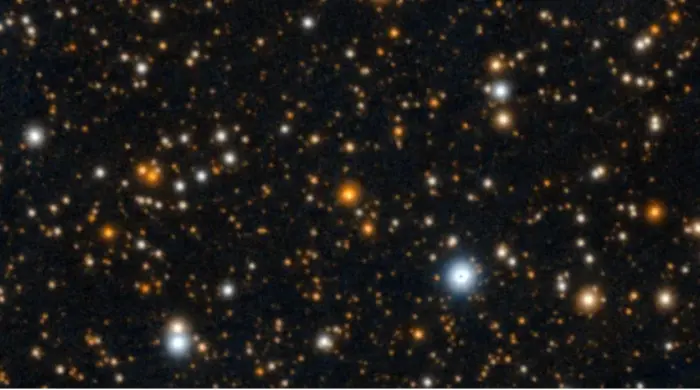
Stephenson 2-18, image: Université de Strasbourg (CC BY-SA 4.0)
The star’s exact parameters are uncertain, but estimates of its energy output are in the range from 90,000 to 630,000 solar luminosities.
The supergiant occupies the top right corner of the Hertzsprung-Russell diagram. The HR diagram shows the relationship between the stars’ luminosities and effective temperatures. The most luminous stars are near the top of the diagram, while the coolest ones appear toward the right side of the diagram.
Size
Stephenson 2-18 has an estimated radius of 2,150 solar radii. If it replaced the Sun at the center of our solar system, it would extend past the orbit of Saturn (2,047 – 2,049.9 R☉). The star’s size corresponds to a volume about 10 billion times greater than the Sun. The only two stars that may come even close to this size are MY Cephei in the constellation Cepheus with a radius 1,134 – 2,061 times that of the Sun and WY Velorum in Vela with 2,028 solar radii.
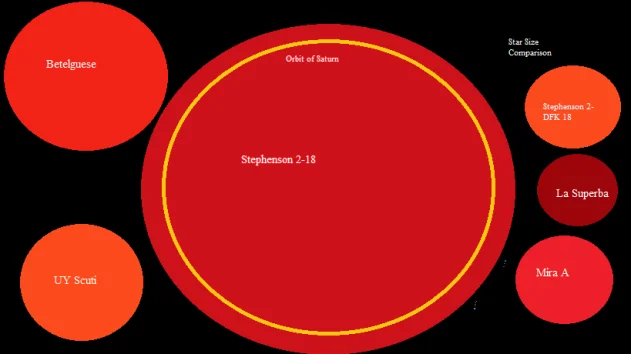
Stephenson 2-18 size compared to other large stars, image: Wikimedia Commons/THE COLOSSAL GALAXY NAMED IC1101 (CC BY-SA 4.0)
With a current radius estimate of St2-18, it would take almost 9 hours to complete a circle around the star’s surface travelling at the speed of light. In comparison, making the same trip around the Sun would take only 14.5 seconds.
The radius of Stephenson 2-18 is above what current stellar evolution theory predicts. The theoretical limit of star size in the Milky Way is around 1,500 solar radii. It is believed that stars larger than this do not form and would be too unstable.
Stephenson 2-18 compared with UY Scuti
Stephenson 2-18 took the title of the largest star known from the previous record holders, the red supergiants WOH G64 in the constellation Dorado and UY Scuti in Scutum. WOH G64 has an estimated radius between 1,540 and 1,730 solar radii, which is considerably smaller than St2-18.
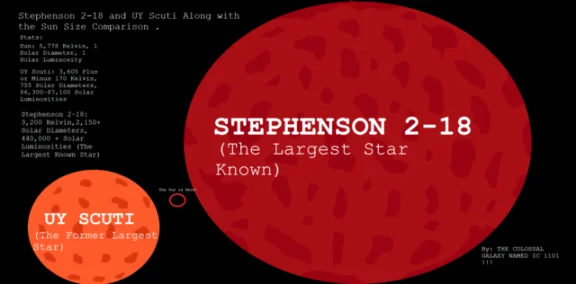
A size comparison of the Sun, UY Scuti and Stephenson 2-18, image: Wikimedia Commons/THE COLOSSAL GALAXY NAMED IC1101 (CC BY-SA 4.0)
UY Scuti had an estimated radius of 1,708 solar radii until more accurate measurements of the star’s parallax in the Gaia Data Release 2 yielded a lower distance and therefore lower values for the star’s luminosity and radius. The estimated radius of UY Scuti is now only 755 solar radii, which is comparable to that of Antares (680 – 800 R☉), but smaller than the radii of Betelgeuse (887 R☉), Mu Cephei (972 – 1,260 R☉), VY Canis Majoris (1,420 R☉), and HR 5171A (1,060 – 1,160 R☉). However, the Gaia data may not be reliable, and the supergiant may indeed be larger.
Facts
The open cluster Stephenson 2 is one of the most massive open clusters in the Milky Way. It was first noticed by American astronomer Charles Bruce Stephenson, who reported the discovery of “ten faint, dust-reddened stars, several of them probable M supergiants, in a 1.5 x 3 arcmin area of sky” in a study published in The Astronomical Journal in June 1990.
Stephenson discovered the cluster during a space-deep infrared objective-prism survey of the northern Milky Way with the Burrell Schmidt Telescope of the Warner and Swasey Observatory. He estimated a distance of 30 kiloparsecs (98,000 light-years) for the cluster based on the assumption that the stars were all red supergiants. Stephenson 2-18 is now believed to lie approximately 18,900 light-years away, at a similar distance as the cluster, but there are still uncertainties regarding its membership.
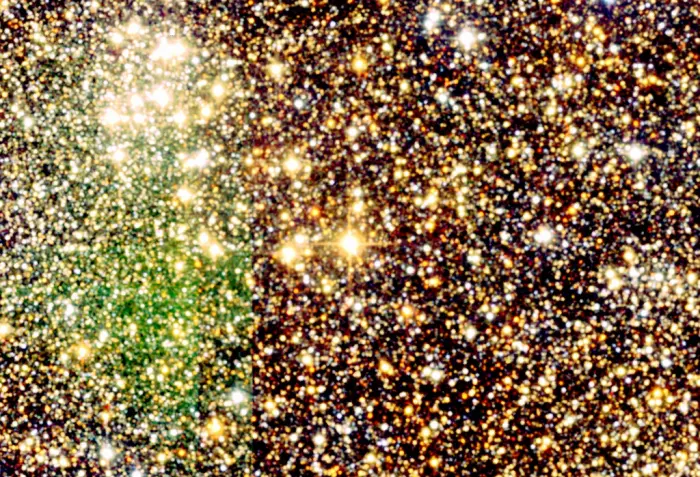
A zoomed-in picture of the evolved red supergiant star Stephenson 2-18, picture processed through 2MASS survey. Image credit: 2MASS (CC BY-SA 3.0)
The cluster stretches across about 6’ of the sky and contains a core group of 26 red supergiants, the largest known population in the Milky Way, first identified in a study published in The Astrophysical Journal in 2007. Study authors estimated a spectral type of M5 or M6 for St2-18 and suggested that the star would soon expel its outer layers and evolve into a luminous blue variable (LBV) or Wolf-Rayet star.
The estimated age of the cluster is 17 ± 3 million years. In the study, the brightest star in the K-band that lay in the same line of sight as the cluster (St2-18) was given the identifier 1. The study concluded that the star likely had considerable infrared excess and may be a red hypergiant like VY Canis Majoris.
A 2012 study reported about 80 red supergiants appearing in the same line of sight as Stephenson 2 (RSGC2), 40 of which had radial velocities indicating that they were members of the cluster. Since these supergiants are spread across a wider area of the sky, they likely form an extended stellar association. The cluster has an estimated mass between 30,000 and 50,000 solar masses and a physical radius of about 4 parsecs (13 light-years).
The cluster is believed to be located at the intersection of the northern end of Milky Way’s Long Bar and the inner region of the Scutum-Centaurus Arm, one of our galaxy’s two major spiral arms (the other being the Perseus Arm).
Stephenson 2 is one of several massive open clusters containing multiple red supergiants located in the constellation of Scutum. The others include RSGC1, RSGC 3, Alicante 7 (RSGC5), Alicante 8 (RSGC4), and Alicante 10 (RSGC6). These clusters appear in the same area of the sky. RSGC1 hosts the red supergiant RSGC1-F01, a star whose radius (1,530 R☉) would extend past the orbit of Jupiter in placed at the center of the solar system.
The clusters RSGC2 (Stephenson 2) and RSGC1 contain about 20% of all the known red supergiants in the Milky Way and are frequent targets for observations studying pre-supernova evolution.
In a study published in 2010, the supergiant was given the identifier 18 and assigned to the Stephenson 2 SW cluster, an aggregation of stars 5’ southwest of the core cluster, believed to lie at the same distance as Stephenson 2.
A 2013 study of the class M supergiants in the cluster Stephenson 2 detected maser emission from the two brightest members of the cluster, indicating that the stars have the highest mass loss rates of all the members.
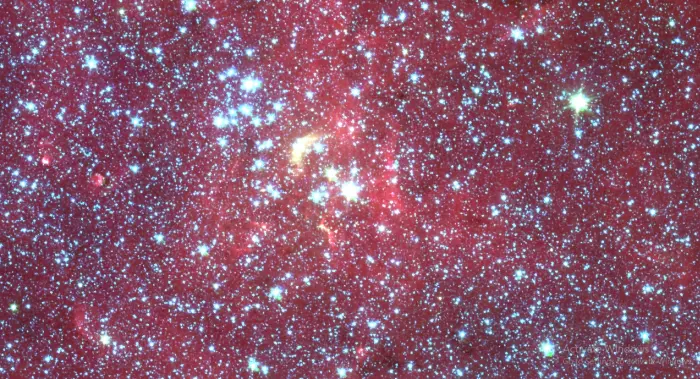
The image depicts one of the largest stars known, Stephenson 2-18, and its supposed and debated parent cluster, Stephenson 2, which contains numerous red supergiant stars. Stephenson 2-18 is a large, luminous, and unusually cool red supergiant or even red hypergiant. In this infrared image from the IRAC HEALPix from the Spitzer Space telescope’s missions, Stephenson 2-18 glows bright, as it has immense infrared excess caused by dramatic mass loss events. Numerous other large and luminous stars are also depicted, including Stephenson 2-DFK 49, a possible post-red supergiant star, IRAS 18357-0604, a yellow hypergiant and Stephenson 2-03 or Stephenson 2-DFK 2, another large and unusually cool red supergiant. Image credit: IRAC HEALPix survey in color from the Spitzer Space Telescope (CC BY-SA 4.0)
Name
Stephenson 2-18 does not have a proper name. Its designation comes from the name of its discoverer, Charles Bruce Stephenson. The star is also known as RSGC2-18 and Stephenson 2 DFK 1.
RSGC2 stands for Red Supergiant Cluster 2. DFK 1 comes from the initials of Ben Davies, Don F. Figer, and Rolf-Peter Kudritzki, who identified a core group of 26 physically associated red supergiants in Stephenson 2 in 2007. St2-18 was given the identifier 1 as the brightest star appearing in the region. However, it was believed to be an unrelated red supergiant.
Location
Stephenson 2-18 appears as a member of the open cluster Stephenson 2, which occupies an area of 1.8’ of the sky but is not visible in amateur telescopes. The cluster cannot be detected in visible light at all because it is heavily obscured by dust, but it can be seen in infrared light. It lies in the region of the sky between Alpha and Beta Scuti.
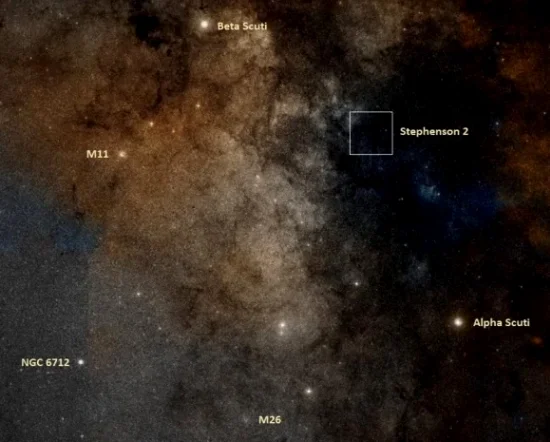
Stephenson 2 location, image: Wikisky
Constellation
Stephenson 2-18 is located in the constellation Scutum. Originally known as Scutum Sobiescianum (the Shield of Sobieski), the constellation was named by Polish astronomer Johannes Hevelius in honour of the Polish King John III Sobieski’s victory in the Battle of Vienna in 1684.
Scutum is one of the smallest and faintest constellations in the sky. It is the 84th constellation in size, stretching across only 109 square degrees of the southern sky. It does not contain any stars brighter than magnitude 3.00. None of its stars make the list of the 300 brightest stars in the sky.
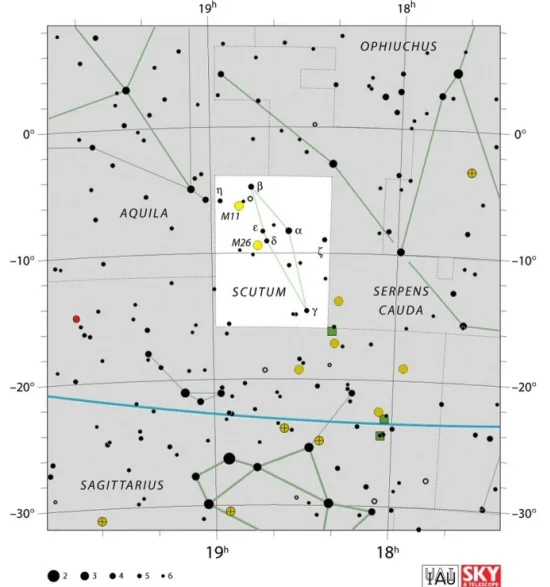
Scutum constellation map by IAU and Sky&Telescope magazine
Scutum is best known for being home to the variable white giant star Delta Scuti, which serves as a prototype for its own class of variables, and to the pulsating variable red supergiant UY Scuti, one of the largest known stars. Notable deep sky objects in Scutum include the open clusters Messier 11, better known as the Wild Duck Cluster, and Messier 26, the massive young clusters RSGC1, RSGC2 (Stephenson 2), RSGC3 and RSGC4 (Alicante 8), the globular cluster NGC 6712, and the planetary nebula IC 1295.
The best time of the year to observe the stars and deep sky objects in Scutum is during the month of August, when the constellation rises high above the horizon in the evening. The entire constellation is visible from locations between the latitudes 80° N and -90° S, i.e. from all inhabited places on Earth.
The 10 brightest stars in Scutum are Alpha Scuti (mag. 3.83), Beta Scuti (mag. 4.22), Zeta Scuti (mag. 4.66), Gamma Scuti (mag. 4.67), Delta Scuti (mag. 4.60 – 4.79), Eta Scuti (mag. 4.83), Epsilon Scuti (mag. 4.88), HD 175156 (mag. 5.08), HD 171391 (mag. 5.12), and R Scuti (mag. 4.2 – 8.6).
Stephenson 2-18
| Spectral class | M6 |
| Apparent magnitude (G) | 15.2631 ± 0.0092 |
| Apparent magnitude (J) | 7.150 |
| Apparent magnitude (H) | 4.698 |
| Apparent magnitude (K) | 2.9 |
| Distance | 18,900 light years (5,800 parsecs) |
| Parallax | −0.1524 ± 0.2330 mas |
| Proper motion | RA: −1.697 ± 0.266 mas/yr |
| Dec.: -4.637 ± 0.221 mas/yr | |
| Luminosity | 436,516 L☉ (90,000 – 630,000 L☉) |
| Radius | 2,150 R☉ |
| Temperature | 3,200 K |
| Constellation | Scutum |
| Right ascension | 18h 39m 02.3694806915s |
| Declination | −06° 05′ 10.556738789″ |
| Names and designations | Stephenson 2-18, St2-18, Stephenson 2 DFK 1, Gaia DR2 4253084565963481856, Gaia DR3 4253084565963481856, MSX6C G026.1044-00.0283, IRAS 18363-0607, 2MASS J18390238-0605106 |